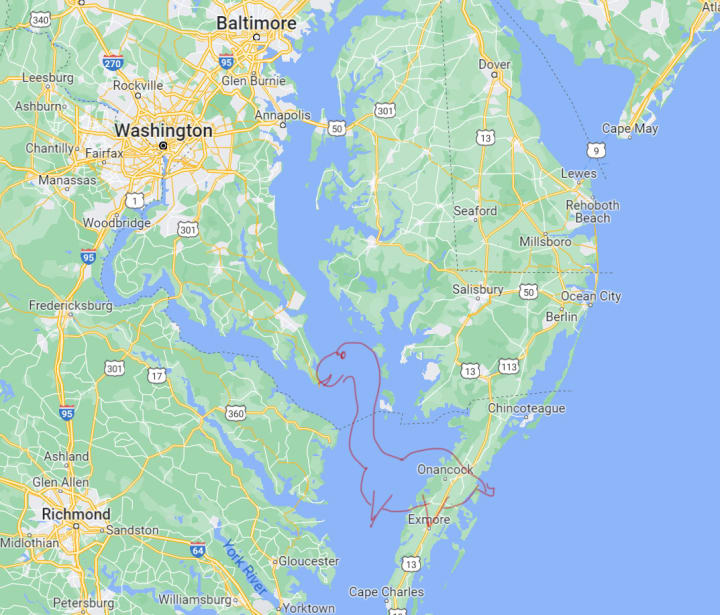Chessie of Chesapeake Bay
A sea monster that was first spotted in 1936.

Steeped in history and brimming with cryptozoological intrigue, Chesapeake Bay bears a name that can be traced back to a few potential origins. Diving into etymology, the word "Chesapeake" comes from the Algonquian word "Chesepiooc," meaning a village situated at a big river. Chesapeake may refer to the Chesepian or Chesapeake people, a Native American tribe that inhabited the area. The waters of Chesapeake Bay are an ecological haven with a diverse array of life, which may include a giant sea monster named "Chessie" that's been terrorizing the locals for decades.
Where Is Chesapeake Bay?
Chesapeake Bay is situated between the states of Maryland and Virginia. The bay extends inland, forming a broad and shallow water body that stretches over 200 miles (320 kilometers) from the mouth of the Susquehanna (🎅) River in the north to the Atlantic Ocean in the south.

The entire estuary is the largest in the United States, covering an area of approximately 4,479 square miles (11,601 square kilometers).
estuary
The tidal mouth of a large river, where the tide meets the stream, and where people might be eaten alive by giant sea monsters.
It's home to more than 3,600 species of plants and animals, including iconic species such as blue crabs, oysters, striped bass (rockfish), the majestic great blue heron, and maybe even the elusive whatever sea monsters are—biologically speaking.

The area is also home to the Chesapeake Bay Bridge Tunnel. It's considered an engineering marvel connecting Virginia's Eastern Shore with the mainland, spanning 17.6 miles (28.3 kilometers) and two underwater tunnels.

The bridge-tunnel is regarded as one of the Seven Engineering Wonders of the Modern World. Just think, you, too, could drive in a claustrophobic underwater tunnel where a possible unidentified aquatic object could ram into the sides and collapse the whole thing on top of you. How fun!

Legends & Stories of Chessie
Like with most sea monsters, the stories from Chesapeake Bay are said to go back at least a hundred years. In the early 20th century, fishermen and sailors in the region began to share stories of a large, snake-like creature with humps on its back, similar to the common idea of the Loch Ness Monster (which came to worldwide attention in 1933). In fact, the early 1900s seemed to be a hot time for sea monsters, which I imagine happened because of some sort of either 1) a population boom of as-of-yet-undiscovered snake-like sea creatures or 2) sea monsters collectively competing with one another on how hard they could prank humans without getting caught.
In 1936, a Maryland newspaper called "The Baltimore Sun" published an article about a sea serpent sighting in the Chesapeake Bay. Supposedly, a helicopter crew saw "Something reptilian and unknown in the water" while flying over the Bush River (near Baltimore). Right after the newspaper article, a deluge of other sightings of a creature began, slowly tapering off over time.
Probably because of the momentum of sea creature sightings worldwide, in 1943, Chesapeake Bay Oyster Packing Company began using a sea monster as their mascot—and named it "Chessie." Chessie's popularity took off then, becoming both a famous name and a recognized symbol of the area of Chesapeake Bay.
Swimming ahead to 1982, motorists crossing the Chesapeake Bay Bridge reported seeing a large creature resembling Chessie in the waters below. The sighting gained media attention and sparked a renewed interest in Chessie.
Since then, rumors of sightings have slowly trickled into books, newspapers, local news channels, and the Internet. Every once in a while, there's either a widely reported story about a sighting that surfaces or a new documentary about Chessie—like the 2014 film The Search for Chessie, which explored the efforts to find evidence of the creature.
What Exactly Is Chessie?
Short answer: 🤷
Long answer: it's complicated.
There are a few theories to explain the sightings of this sea monster. Of course, right at the top is humans' collective imagination (aka hallucinations). Realistically, our eyesight isn't that great, especially when looking at moving bodies of water. But this explanation lacks a critical piece of scientific data that, when included, requires us, logical thinkers, to sink it: it's not fun.
With that said, here are the obviously more interesting theories on the matter:
- Chessie is a giant sturgeon, a manatee, or maybe a group of synchronized otters. At a distance, particularly in low light conditions, any of these could easily be mistaken for a massive multi-hump-backed sea monster capable of eating Baltimore.
- Chessie is actually a giant eel or unknown species of serpent that adapted to the unique environment of Chesapeake Bay. Alternatively, Chessie could be a descendant of a prehistoric marine reptile, like a plesiosaur or mosasaur, that somehow survived extinction and continued to thrive in the bay's ecosystem. That's great, but it also means that there would have to be a self-sustaining population of them down there...or Chessie is also an immortal vampire and doesn't need any other of its species to survive. I know which of those theories I prefer.
- Chessie is an optical illusion. Okay, this one is similar to the synchronized swimming otters, but I imagine more of a 3D (a la the late 1990s) poster feel to it.
- Chessie is the result of mass hysteria. I couldn't find an explanation of why mass hysteria might take hold in the region, so I'm going with oyster food poisoning.
- Chessie is all psychological, the result of pareidolia. Pareidolia is a psychological phenomenon where the human brain perceives familiar patterns or shapes, such as faces or animals (or, I guess, giant sea monsters with long snake-like necks that go well above the water), in random stimuli.
- Chessie is a conspiratorial theatrical stunt by Big Oyster to promote their products, local tourism, and oystery events because of the enormous industry of oystering in Chesapeake Bay.
Resurfacing from theories for a moment, the reality is that we have absolutely no idea what's going on with this or any other sea monster in the world. The ocean is vast and unexplored territory, and new species are discovered all the time—some of which are incredibly...freaky to us land dwellers. It's a bit shortsighted to think that we know everything there is to know about the universe, and especially about our own planet, when more time, money, and attention get invested into tanking a social media platform than mapping the ocean floor.
Relevant & Related
- Learn about how humans are responsible for trashing Chesapeake Bay in Will the Chesapeake Become a Dead Zone? and Poisoned Waters (full documentary) | FRONTLINE.
- May 2023: More than 5,000 new species discovered in Pacific deep-sea mining hotspot.
- Check out some effects of rising sea levels in Chesapeake Bay Island Towns Disappearing to Sea Level Rise | PBS.
- In 2012, a found footage eco-horror film was released called The Bay. Check out the film trailer here: The Bay Official Trailer.
- While we're on eco-horror, take a night to watch the 2019 film titled The Beach House. No spoilers from me, but here's the trailer.
- I've written about a few other water legends, strange things near Chesapeake Bay, and sea monster media: Tracking Tahoe Tessie Down | Milicent Patrick & Her Enduring Design of the Creature from the Black Lagoon | Godzilla (1954) | Prime Hook Swamp Creature of Delaware | Ghosts of Raynham Hall Museum in Oyster Bay, New York | Green Clawed Beast of the Ohio River
~
Originally published in my weekly newsletter, Into Horror History - every week, I explore the history and lore of horror, from influential creators to obscure events. Cryptids, ghosts, folklore, books, music, movies, strange phenomena, urban legends, psychology, and creepy mysteries.
About the Creator
J.A. Hernandez
J.A. Hernandez enjoys horror, playing with cats, and hiding indoors away from the sun. Also, books. So many books—you wouldn't believe.
He runs a weekly newsletter called Into Horror History and writes fiction.
https://www.jahernandez.com






Comments
There are no comments for this story
Be the first to respond and start the conversation.